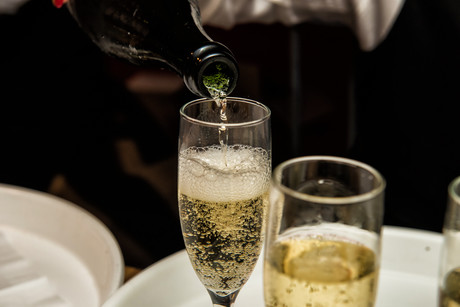The sound of good bubbly

With New Year’s quickly approaching, the hunt for the perfect champagne has begun. But how can you tell which is the best? A new study suggests you may be able to differentiate between a high-quality glass of champagne and cheap bubbly just by listening to the sound of the bubbles.
Researchers from the Applied Research Laboratories at the University of Texas listened to the underwater acoustics of bubbles using a hydrophone in order to determine whether it can provide quality assurance. The research was presented at the 174th Meeting of the Acoustical Society of America in New Orleans, Louisiana.
“Bubbles are very resonant. They basically ring like bells, and the frequency of that ringing depends in part on the size of the bubbles. There is a well-known notion that the quality of a sparkling wine is correlated to the size of its bubbles, and we are investigating whether the bubble size distribution of a sparkling wine can be obtained from simple acoustical measurements,” said researcher Kyle Spratt.
However, they encountered several difficulties when gathering their data. Firstly, Spratt said that bubbles formed on the hydrophone itself, which could have skewed their results, so they tried using a much smaller hydrophone. Also, champagne is traditionally drunk out of a flute-shaped glass, but researchers realised that different containers can impact the bubble formation.
“A wine glass is also a resonant object, so another challenge for us was to make sure that the characteristics of the glass itself weren’t biasing our measurements in some way,” said Spratt.
To account for this, the researchers tested other containers such as a Styrofoam cup, but they found that foam or plastic cups encourage bubbles to stick to the sides, causing them to increase in size.
So whether it is smaller bubbles that are associated with more expensive champagnes, or larger bubbles that give off a stronger aroma and texture, the study could help identify the quality of wine in the future. This does not just apply to sparkling wines, but also other carbonated beverages.
“The direct application would be as a simple tool that could be used to monitor the bubble size distribution in sparkling wines,” Spratt explained.
Maybe we should do some taste tests to judge for ourselves.
Mimicking meat: texture science for plant-based meats
Stanford engineers are developing an approach to food texture testing that could pave the way for...
What's new on the shelf in the lead-up to Christmas
Chocolate baubles, fruity snacks, Milkybar milk and instant coffee with a cool twist are some of...
A vision of a food trend
Research at the University of Sydney tested the reactions of more than 600 people making food...










